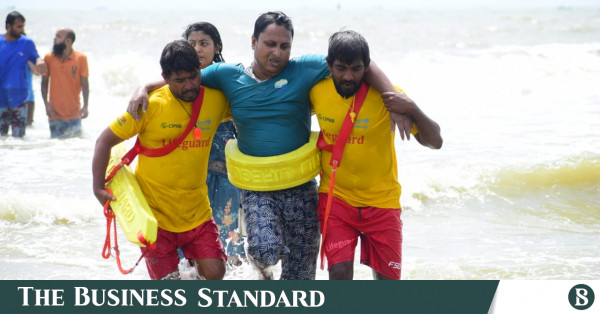In 2013, Zainal Abedin Bhutto experienced a significant moment when he saved a child from drowning in the Bay of Bengal, creating a cherished memory.
The child, distressed and struggling in the water, was at risk of being swept away before Bhutto, without any equipment, bravely plunged into the Bay from Cox’s Bazar sea beach to reach the child in need.
Having already been submerged twice, the child’s situation was critical. Bhutto’s timely intervention prevented a potential tragedy as he managed to bring the child safely back to the shore.
The child’s parents, initially losing hope, were overwhelmed with gratitude upon being reunited with their little one, expressing their heartfelt thanks to Bhutto through tearful embraces.
This heroic act occurred before Bhutto’s tenure as a professional lifeguard, a role he now fulfills diligently for eight hours daily at Cox’s Bazar beach, overseeing the safety of beach visitors at Laboni Point, Sugandha Beach, and Kalatali Beach alongside a team of 27 lifeguards.
The lifeguards operate in two shifts daily, with the first group commencing at 7 am and the second at 11 am. During winter, their shifts are reduced by an hour, adapting to seasonal changes.
The Role of Lifeguards and the Significance of the Red-Yellow Flag
At each designated point, typically manned by three to four lifeguards, a systematic approach is followed to ensure beach safety. Beginning with a thorough assessment of sea conditions, the lifeguards identify a 400-meter safe zone based on factors like current speed and onshore canal location.
Two red-yellow flags are strategically positioned at the boundaries of this safe area, accompanied by a watchtower at the center for enhanced surveillance. Environmental data, including wind direction, air and water temperature, wave height, and tide schedules, are meticulously recorded and displayed at the tower for public awareness.
Employed by the Center for Injury Prevention and Research, Bangladesh (CIPRB), under the Sea Safe project, Bhutto holds a senior position among the lifeguard crew, leveraging his expertise and experience to ensure beach safety.
Training and Professional Growth
Bhutto’s journey to becoming a proficient lifeguard traces back to his admiration for renowned surfer Zafar Alam, whose skills and passion for surfing inspired Bhutto to pursue training in water sports. Despite his initial foray into surfing, Bhutto’s trajectory shifted towards lifesaving, culminating in his professional lifeguard role.
Trained by the UK’s Royal National Lifeboat Institution (RNLI) in 2011, Bhutto and his fellow surfers underwent rigorous instruction on wave dynamics, rescue techniques, and first aid protocols, preparing them for the demanding task of safeguarding beachgoers.
For three years, Bhutto volunteered his services on weekends and holidays, honing his skills and commitment to water safety before transitioning to a paid lifeguard role in the Sea Safe Project in 2014.
Challenges and Rewards
Amidst the challenges and risks inherent in lifeguard duties, Bhutto finds immense satisfaction in saving lives and being a beacon of safety for beach visitors. Despite facing tragic incidents like multiple drownings in 2023, Bhutto remains dedicated to his role, driven by the profound impact of his life-saving interventions.
As a coach and mentor to new volunteers, Bhutto embodies a commitment to continuous learning and skill development, ensuring the sustainability of lifesaving efforts beyond his tenure. With a clear mission to eliminate drowning incidents through proactive rescue measures and community awareness, Bhutto envisions a future where beach safety is paramount.
At 33 years old, with a young family to support, Bhutto’s unwavering dedication to his lifeguarding profession underscores the profound impact of his selfless acts of heroism, resonating with his daughter and the community as a whole.
